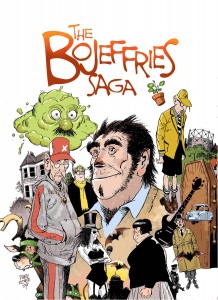The Bojeffries Saga
Reviewed by Tony Keen 13-May-14
At last, all the Bojeffries strips in one place, in black-and-white. Plus a new strip that isn’t very good.
 In amongst all of Watchmen, League of Extraordinary Gentlemen, V For Vendetta, etc., it is sometimes forgotten the Alan Moore is not only one of the best English comics writers of the late twentieth century, but also is one of the best comic writers. This side is often quite hidden in the superhero stuff (though note his Green Lantern Corps story “Mogo Doesn’t Socialize”), but it’s clearly on display in Maxwell the Magic Cat, and Tomorrow Stories.
In amongst all of Watchmen, League of Extraordinary Gentlemen, V For Vendetta, etc., it is sometimes forgotten the Alan Moore is not only one of the best English comics writers of the late twentieth century, but also is one of the best comic writers. This side is often quite hidden in the superhero stuff (though note his Green Lantern Corps story “Mogo Doesn’t Socialize”), but it’s clearly on display in Maxwell the Magic Cat, and Tomorrow Stories.
The apogee of Moore’s comic writing is The Bojeffries Saga. Described by its creators as “a paranormal soap opera”, it is actually more like Hancock’s Half-Hour commissioned by the SyFy Channel and written by Graham Linehan. The reader is introduced to a fairly nondescript family living in a nondescript house in a nondescript Midlands town – except that the family includes a vampire and a werewolf, haven’t paid rent since the nineteenth century, and the hatch into the loft leads into the back garden.
The various tales, as the family deals with works dos, holidays, Christmas, etc., are all brilliantly drawn by Steve Parkhouse at his most cartoonish, in a style which recalls the best of British kids’ humour comics. And Moore’s scripts remain laugh-out loud funny, though a few aspects have worn less well than the strip overall – notably the parody of radical feminism that is Ginda Bojeffries.
This collection brings together all the excellent strips that appeared since 1983 (though missing various one-page illustrations and covers). It also includes a ‘brand new’ (actually written and drawn in 2009) 24-page story that is … well, a bit poor, actually. The problem isn’t with the art – though it looks a bit different, having been produced on a tablet rather than on a board, and Parkhouse employs a lot of washes that are untypical of his earlier work, the art delivers. The problem is the script. The Bojeffries Saga is dark, and surreal, but one thing the earlier strips never were was cynical. The new story, “After They Were Famous”, bleeds cynicism. Moore in the 1980s was annoyed at some aspects of British life, but for the most part indulged in affectionate mocking of national absurdities; the Moore of 2009 is an angry man, pretty pissed off at what the country has become. Not that I blame him – the neoliberal policies followed by Thatcher and Blair (and now by Cameron) have made Britain in many ways a pretty shitty place to live. But such feelings do not a funny comic make.
Fortunately, the new strip is irrelevant to whether you should buy this collection or not. You should. If you’ve never read the original stories, or haven’t read all of them, or read them ages ago in someone else’s copy, you should buy this so that you have your own complete collection. If you have all the originals, they’re scatted across various different titles, and you should buy this to have them all in one place. Even if you have 1992’s The Complete Bojeffries Saga, that was in colour, and these strips were meant to be appreciated in black-and-white.
So go place your order.
Tags: Alan Moore, Bojeffries Saga, Knockabout Comics, Steve Parkhouse, Top Shelf